|
By Donald H. Harrison
SAN DIEGO, Calif.—Being eighth graders at Soille San Diego Hebrew Day
School, Rebecca Goodman, Hayley Schonland, Zoe Jurkowski have been taught
all there is to know about preparing a proper cup of tea—Rube Goldberg style,
that is!
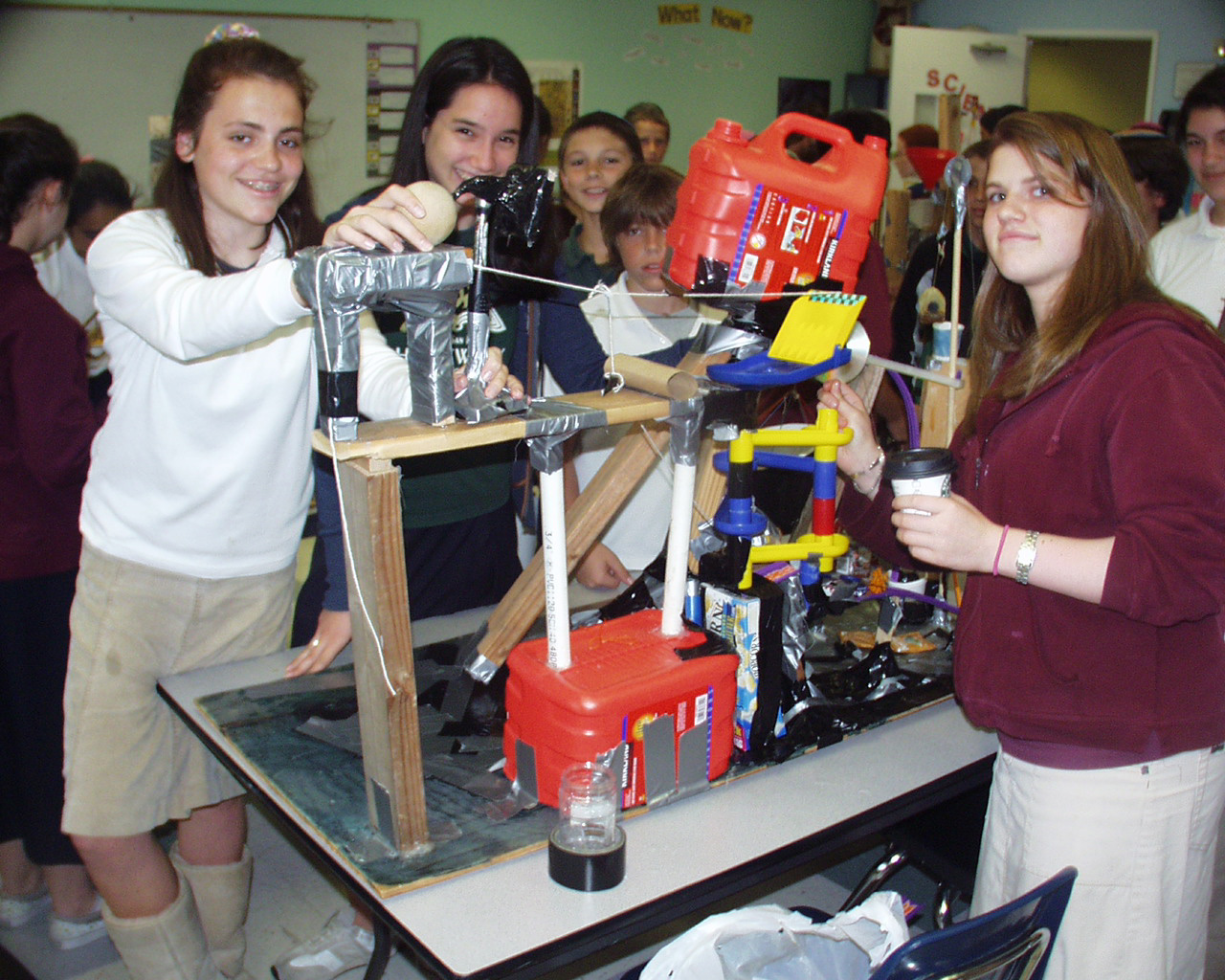 Just ask them for the beverage, and one of them will roll a ball, which will hit
a hammer, which will release a pulley, which will trigger a lever, which will
hit an object. Eventually a string that is attached to a tea bag will be
cut, making
the tea bag fall into a pot of hot water. Meanwhile sugar in
another container will fall into the cup as
well. And, for the piece de resistance, a pulley will pull the tea
bag out of the water.
Just ask them for the beverage, and one of them will roll a ball, which will hit
a hammer, which will release a pulley, which will trigger a lever, which will
hit an object. Eventually a string that is attached to a tea bag will be
cut, making
the tea bag fall into a pot of hot water. Meanwhile sugar in
another container will fall into the cup as
well. And, for the piece de resistance, a pulley will pull the tea
bag out of the water.
The girls study physics in a class taught by general science
teacher Julie Reynolds, whose students for six years have been major forces in
the Greater San Diego County Science Fair competition. Typically, 90 percent of
the
Ye olde tea maker
projects done by her students will be chosen to advance from the school
level to the county science fair level. In two of her six years, 100
percent of her students were advanced to the county science fair. "I
think the average is generally 10 percent from any particular school," she
said.
This year, three of Reynolds' students—who also are
participating in the "Rube Goldberg" demonstrations which end
tomorrow—will advance from the county science fair to the state science
fair compeition next Monday and Tuesday in Los Angeles.
Rube Goldberg was a Pulitzer Prize-winning editorial cartoonist who not only could draw
biting commentaries on the issues of the day, but who also liked to design
improbable machines to do simple tasks, such as the one created by Goodman,
Schonland and Jurkowski. Among politicians and public administrators
today, one occasionally will hear a policy or program attacked as a "Rube
Goldberg"—that is, an option which is far more complicated than
necessary.
For Reynolds' students, the idea was to learn about basic principles in physics
in an enjoyable way. Each team of students was required to devise mainly
from recycled materials an invention with at least 12 steps. Their
instructions said: "You must invent a runway that allows a ball to drop one
foot, rise six inches, travel a total of three feet horizontally, make a
360-degree turn, knock over a six- inch tall object, and complete a simple
task." Furthermore, the students were told that their inventions must
include a lever, pulley, and an inclined plane," as well as their choice of
other simple machines, such as a screw. "Electricity and magnets are optional, but may be
used," the instructions said. "You may touch the contraption
only to initiate the action."
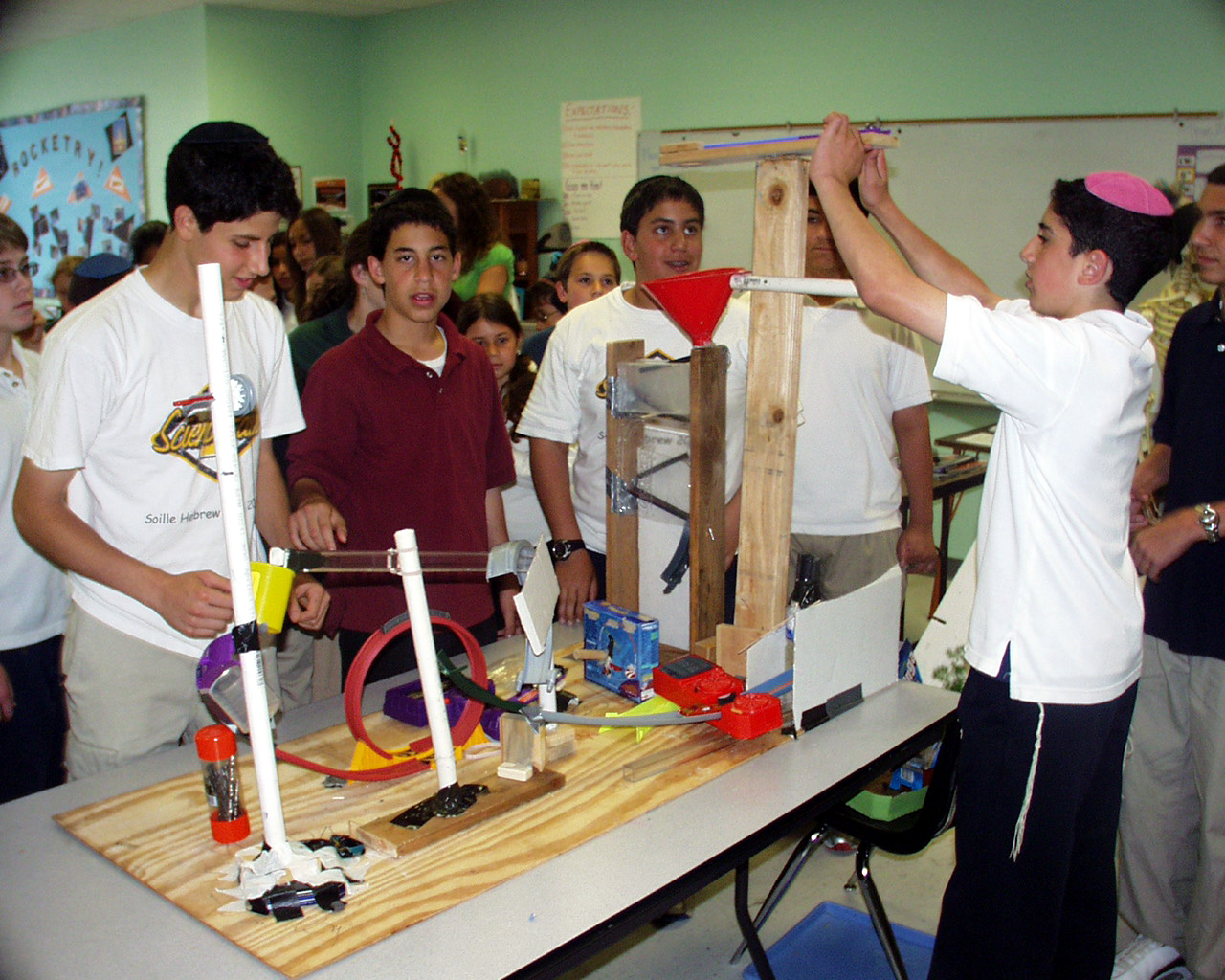 At a nearby work station, Daniel Dimont—one of the three State Science Fair
entrants—teamed with David Bogopulsky, Ariel Halevy and Yosef Rosenberg on a
machine that, after a variety of mechanical processes, ended up watering a
plant.
At a nearby work station, Daniel Dimont—one of the three State Science Fair
entrants—teamed with David Bogopulsky, Ariel Halevy and Yosef Rosenberg on a
machine that, after a variety of mechanical processes, ended up watering a
plant.
Dimont narrated the process:
A ball is placed on this hole, and as we push the plank of wood
up, it is considered a lever, and the ball flows down. Then the ball falls
out of a hole in the back of a plank and falls into a funnel. It
goes through the funnel. Then it falls into a series of inclined planes;
the inclined planes change directions until it falls into another trap, that
makes the direction (become) forward into the rest of our project. Then it
hits a ... packet of oatmeal bars, and there is a wooden stick hanging out of
the oatmeal bar,
Gardening for 'Rubes'
and that hits the edge of a (toy) hot wheels car. The hot
wheels car travels 3 or 4 inches on a little track on a ramp. It hits a
hot wheel launcher. The hot wheel launcher takes it through a 360-degree whip
and it goes up the rest of the track and as it loses speed it will land directly
into the pulley. The pulley on the other side goes up and hits a ball that
is on a little drill thing that is holding it together on a lever. Then
the ball goes down, and it travels and hits another series of suspended
tracks; it goes 1-2 and the direction changes. The ball falls down,
hits another hot wheels car onto another launcher. The hot wheels car goes, and
hits a water bottle. The water bottle falls down, and the water goes down a ...
box and right onto the plant, and waters the plant.
Seeing it is believing it! And watching how the students gather around the
inventions, cheering when the ball makes it all the way through the
complex course, testifies to how fully engaged they are in this learning
exercise.
Other student groups also had ingeniously impractical machines. Miriam Alpert, Lev Mizan,
Jessica Silvers and Lisa Felber built one that could flip a coin—a
decision-maker, in other words.
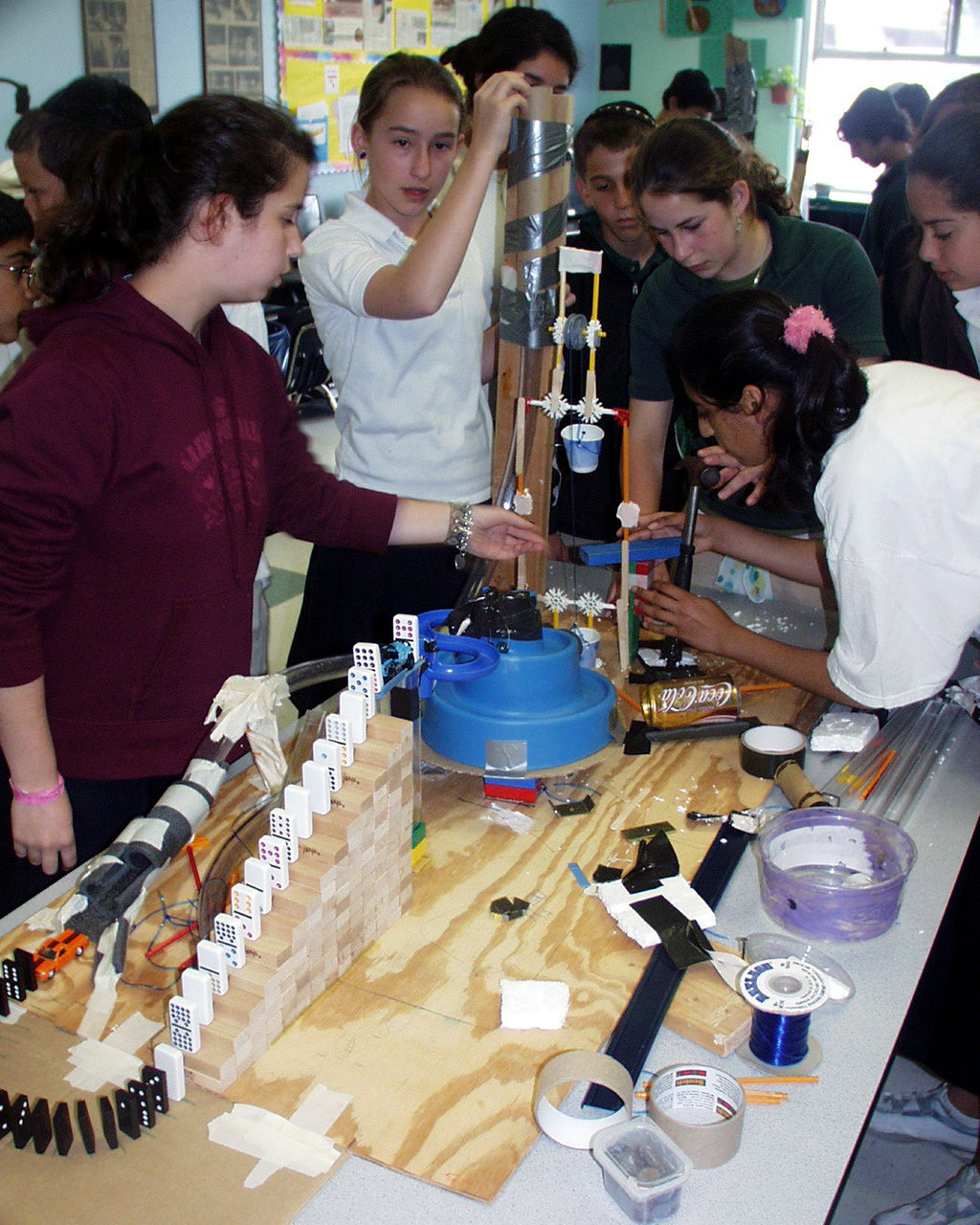 Stefanie Bailund-Witty, Shir Hebron, Daniel Rajlevsky-Cohen, and Hannah Fechter
devised one which, after the required steps including stair-climbing dominoes,
made a hammer fall on an empty soda can, thereby crushing it for the recycling
box. Stefanie Bailund-Witty, Shir Hebron, Daniel Rajlevsky-Cohen, and Hannah Fechter
devised one which, after the required steps including stair-climbing dominoes,
made a hammer fall on an empty soda can, thereby crushing it for the recycling
box.
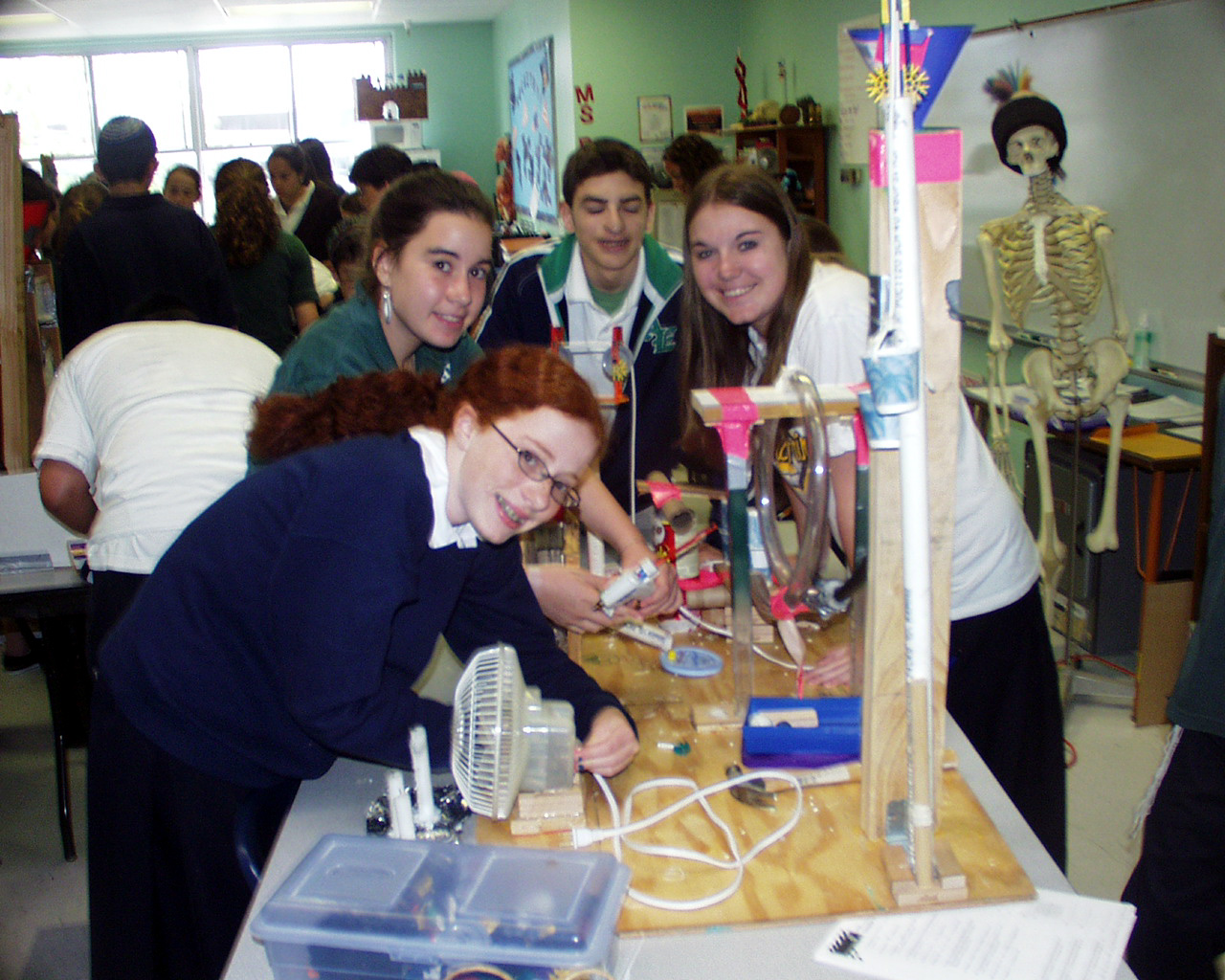 Josh Levi, Samantha Maisel, Miri Resnick-Levine, and Margalit Wollner invented a
machine to blow out a candle.
Josh Levi, Samantha Maisel, Miri Resnick-Levine, and Margalit Wollner invented a
machine to blow out a candle.
And, Max Gonzales, Eliran Placencia -Chomoshe and Zev Warhaft figured out how a machine could
The Amazing Can Crusher
Genuine Candle-blower
be made to cut a piece of fruit. How could any home be complete
without such miraculous inventions?
To get into the State Science Fair, Dimont "tested different types of
water—bottled water, tap water, mineral water, all these types, and distilled
water (which was his control), and he tested hardness, Ph, total dissolved solids
and more, and he put them all through a Brita water filter, and looked how that
affected the water," Reynolds said. "Did it take out the chlorine? Did it change the
total dissolved solids? Did it lower the hardness of the water? He did some comparisons."
Felber undertook a mathematical project, "looking at the probability of whether
to hold or hit playing blackjack with a 16," the teacher chuckled.
"So she went through all the probabilities depending on what the dealer
had, all of that—so that was her project, a very intense statistics
project."
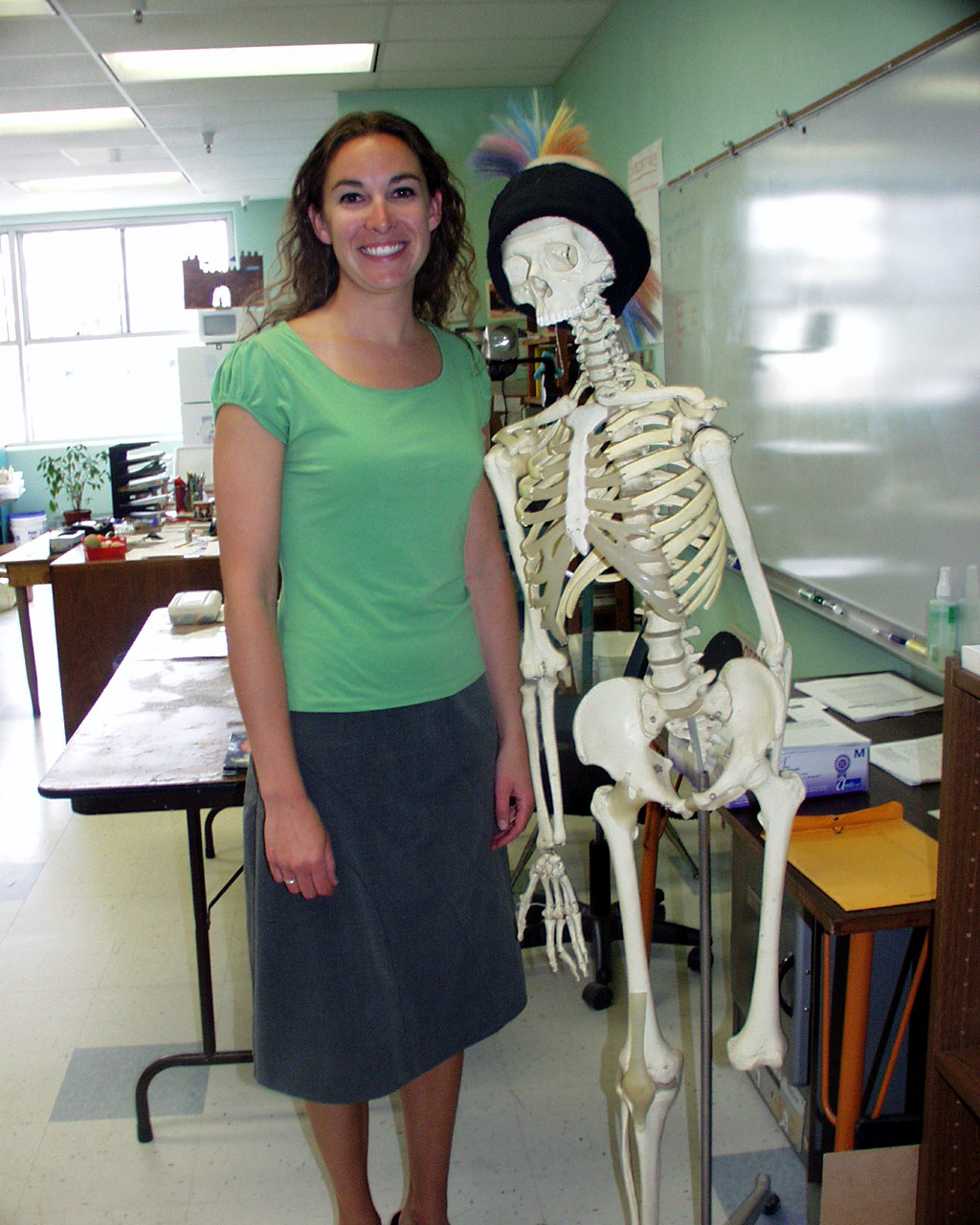 Silvers, an eighth-grader who was chosen for a special program to work with
graduate students in a
Scripps Research Institute's microbiology laboratory under Dr. Ben Cravatt,
"tested bacterial levels on lettuce," Reynolds said. "There have
been stories in the news about a big outbreak in Minneapolis... from pre-washed bad
lettuce. So she tested regular lettuce that you buy in the store, just out of
the containers—how much bacteria does that have, just like that? If you
rinse at home, like you normally would? She tested that. And then,
she tested that against the bagged lettuce, pre-washed, if you don't wash at
all. She did find that the pre-washed had less bacteria but they all had
some bacteria on them."
Silvers, an eighth-grader who was chosen for a special program to work with
graduate students in a
Scripps Research Institute's microbiology laboratory under Dr. Ben Cravatt,
"tested bacterial levels on lettuce," Reynolds said. "There have
been stories in the news about a big outbreak in Minneapolis... from pre-washed bad
lettuce. So she tested regular lettuce that you buy in the store, just out of
the containers—how much bacteria does that have, just like that? If you
rinse at home, like you normally would? She tested that. And then,
she tested that against the bagged lettuce, pre-washed, if you don't wash at
all. She did find that the pre-washed had less bacteria but they all had
some bacteria on them."
Before joining the Soille staff six years ago, Reynolds, a University of
Wisconsin graduate, was a substitute teacher in the San Diego Unified School
District. Her college degree was in education for grades 1-9 with a
minor in psychology. "I wasn't a science major," she said.
"In fact, I hated science." But as a student teacher, she worked
under a "great" science teacher
Teacher Julie Reynolds and 'Harry Bones'
who "didn't use the textbook,
just did all hands-on, and I really liked it, so then I chose for my actual
full-time student teaching to be in a math-science 6th grade program in Madison,
Wisconsin."
Somewhere, genes may have had something to do with
Reynolds' amazing success as a science teacher. Her father is an
astrophysicist.
Not Jewish, Reynolds said working in an Orthodox Jewish school has imposed no
restrictions whatsoever on the way she teaches science. For example, she said,
she teaches the Theory of Evolution, utilizing generally accepted time-tables
concerning when the Earth was formed and animal species were
differentiated, notwithstanding the fact that Torah provides a different
time-table. She said she explains that a "theory is something that
can't be proven" but for which scientists have found various kinds of
evidence.
Although Reynolds does teach anatomy, in fact, keeping "Harry Bones,"
the skeleton in her class, sex education is not in the secular curriculum.
Middle-school level boys and girls are taught those "facts of life" in
separate classes in the Judaic Studies Department, where emphasis can be placed
on derech eretz, appropriate behavior.
|

